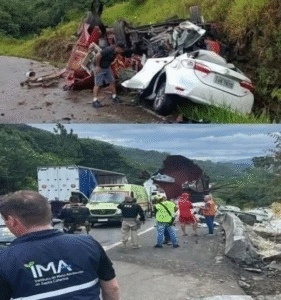Community Shaken After Balcony Collapse: How a Sudden Structural Failure Injured Several People and Sparked a Nationwide Conversation About Building Safety
On a quiet Saturday afternoon, just as the sun dipped toward the horizon and cast a warm glow over the Maple Ridge apartment complex, residents were preparing for what should have been an ordinary evening. Families grilled dinner on patios, students lounged with textbooks, and neighbors gathered on balconies to enjoy the first mild weekend in months. Within minutes, that calm was violently shattered.
At 6:14 p.m., the second-floor balcony of Building C collapsed without warning, sending eight people plunging nearly 15 feet to the courtyard below. The sound, described by multiple residents as “a thunderous crack followed by screaming,” echoed across the complex. The incident has now left several injured, a community shaken, and officials across the country re-examining the safety of thousands of balconies, decks, and elevated structures.
A Scene of Panic and Chaos
Witnesses say the collapse happened during a small gathering. Four friends were sitting at a patio table when the balcony began to shake. Several more people stepped outside to check on the noise—just as the support joists snapped.
“It looked like the balcony just peeled away from the building,” said Maria Ortega, who lives across the courtyard. “One moment they were laughing, and the next they were gone. It happened so fast nobody had time to react.”
Neighbors rushed to help, some climbing down from adjacent balconies while others ran from the ground floor with towels and water. A few residents with medical training immediately assessed injuries until paramedics arrived.
The victims, ranging in age from 19 to 42, suffered injuries including broken wrists, fractured ribs, sprained ankles, and deep bruising. Two individuals remain hospitalized with more serious injuries, but officials say both are expected to recover.
Initial Investigation Points to Structural Weakness
City inspectors wasted no time launching an investigation. By the next morning, yellow caution tape surrounded the complex, and residents were instructed to stay clear of all balconies until further notice.
According to preliminary findings, the balcony’s failure appears to have been caused by a combination of dry rot, water intrusion, and insufficient maintenance—problems experts say are disturbingly common in older multi-unit buildings.
“From what we’ve seen, moisture likely penetrated the wood framing years ago,” said structural engineer Darrell Kim, who was hired by the city to assess the damage. “Over time, this weakens the structural members significantly. Many of these issues can’t be seen from the outside until it’s too late.”
Residents expressed anger, saying they had reported concerns about soft spots and visible cracks months earlier. Some allege that property managers only performed cosmetic repairs instead of addressing the underlying problems.
“We kept telling them something wasn’t right,” said tenant Jaylynn Carter. “The railing shook when you leaned on it. Boards creaked loudly. They would just paint over things. Now people are hurt because no one listened.”
The property management company issued a brief statement expressing sympathy for the injured and promising full cooperation with investigators. They declined to comment further pending the official report.
A Wake-Up Call With National Implications
While this collapse has deeply affected one community, experts say the implications extend far beyond Maple Ridge. Across the United States, tens of thousands of balcony structures are nearing or exceeding the end of their intended lifespan—especially those built in the 1980s and 1990s.
A 2022 study by the National Property Safety Board found that one in ten exterior elevated structures showed signs of significant deterioration, many of which had gone unreported or undetected. In areas with high rainfall, humidity, or insect activity, the risk is even higher.
Balcony failures, though often underreported, are more common than most people realize. Over the past decade, more than 6,500 injuries nationwide have been linked to collapsing decks or balconies. While most involve private homes, multi-level apartment complexes account for a growing share of incidents due to aging infrastructure and delayed maintenance.
The Maple Ridge collapse has now triggered renewed calls for stricter building inspections, increased transparency from property managers, and clearer maintenance guidelines.
“This can’t be treated as an isolated incident,” said Senator Alicia Harmon, who announced plans to introduce federal guidelines for periodic balcony inspections. “We need national standards to ensure that no family, anywhere in this country, is put at risk by preventable structural failures.”
Communities Re-Evaluating Their Own Buildings
In the days following the collapse, nearby cities began conducting their own rapid safety assessments. Social media filled with posts from tenants asking landlords to inspect balconies, while homeowners shared photos of suspicious cracks and sagging boards.
Local contractors and engineers reported a spike in calls.
“I’ve had more inspection requests in three days than I usually get in a month,” said contractor Eli Peterson. “People want peace of mind. They want to know their homes are safe.”
Some property owners have taken drastic precautions, immediately closing off elevated patios and walkways until professional assessments can be made. While inconvenient, many residents say the inconvenience is worth it if it prevents another tragedy.
The Human Impact: Trauma, Solidarity, and Healing
Beyond the structural and political discussions, the emotional impact on the Maple Ridge community has been profound. Children who witnessed the fall are struggling to sleep. Several residents say they’re afraid to step onto their own balconies—even if they’re on the ground floor. Parents have begun gathering in the courtyard in small circles to talk, offering support to one another.
A community fundraiser set up for the injured surpassed its goal within 24 hours. Local restaurants donated meals, and a nearby hardware store offered free materials to help speed up safety repairs.
One of the victims, 24-year-old nursing student Alicia Morgan, shared a message from her hospital bed: “What happened was terrifying, but I’m grateful to everyone who rushed to help us. I hope this leads to real change so no one else has to go through something like this.”
Her words have resonated with residents, many of whom now see themselves as part of a collective push for reform.
Where Things Stand Now
As of this week, all balconies at Maple Ridge remain closed. Contractors have started removing portions of exterior siding to check for hidden rot. The city has promised a full report within a month, and residents are demanding accountability for any missed warning signs.
Despite the fear and uncertainty, the community is determined to move forward—but with eyes now wide open.
“What we all learned,” said resident Mark Jefferson, “is that safety is not something you assume. It’s something you inspect, maintain, and demand. This should never have happened—but maybe it can stop it from happening somewhere else.”
For a community forever changed, that hope has become a driving force.


